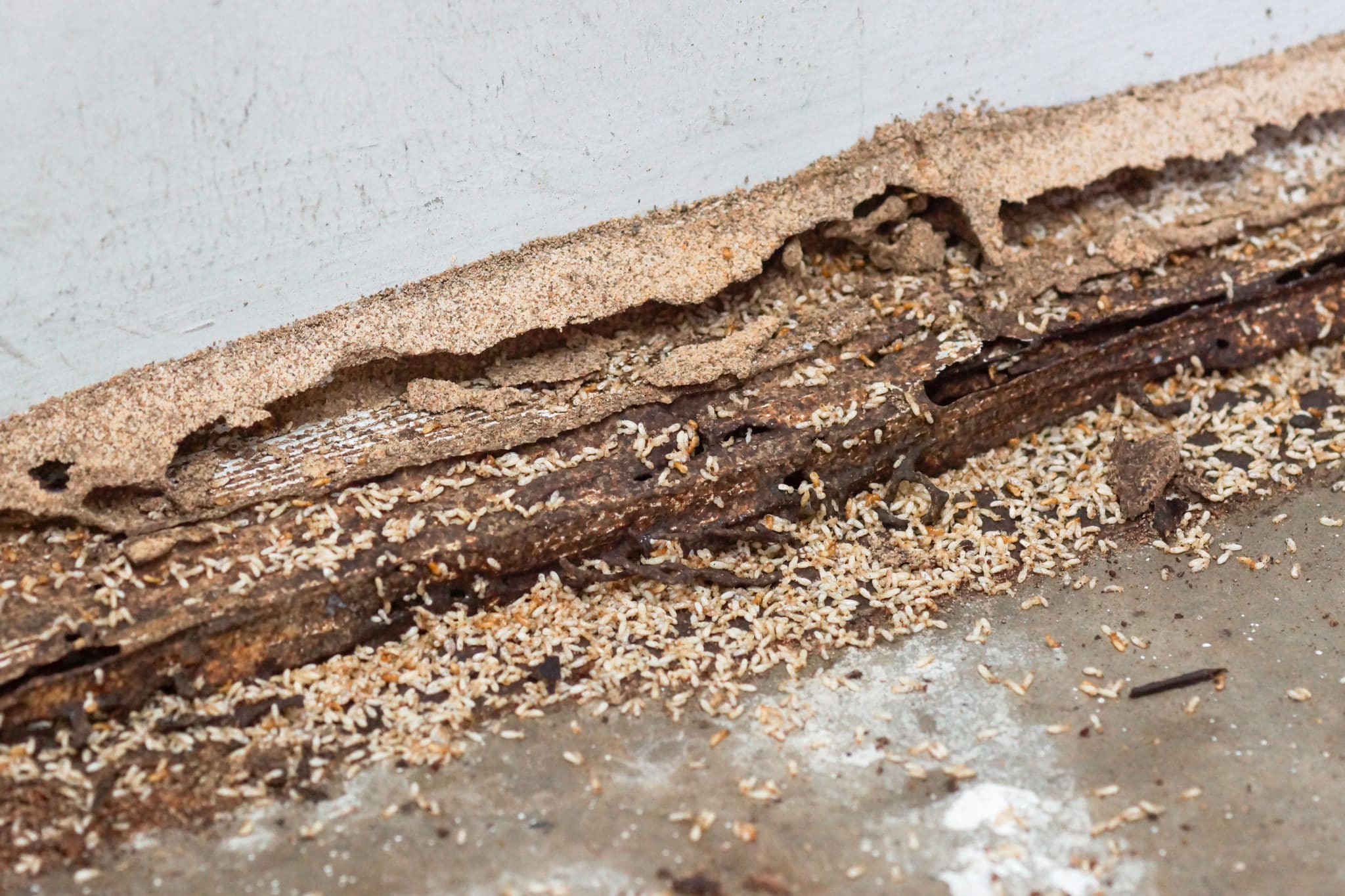Termites, Termites Everywhere: A Termite Inspection Case Study
By Alyssa Cink
Last Updated November 9, 2023

The following is a real termite inspection, errors and omissions (E&O) case study from our home inspection insurance archives. To protect the insured’s identity, all identifiable characteristics—including names, associations, and locations—have been altered or removed.
Just shy of Saint Patrick’s Day, Luke, a home inspector, saw his afternoon take a very unlucky turn. He and his employer were getting sued for an inspection Luke had performed almost a year earlier. The client accused him of missing several defects, including:
- Improperly anchored beams and joists in the first and second floors.
- The same joists were not designed to support the building’s weight. For example, the first-floor joists could only support a 50-pound live load; visitors would need to stand strategically to avoid the floor collapsing beneath them. The second floor’s joists could support even less.
- Fresh paint in specific areas of the garage, presumably to obscure water damages and recent repairs.
- The floors, made with two-by-fours, lacked subfloor or insulation coverage in several areas.
Finally, the client accused Luke of neglecting to report evidence of termites. The worst part: She didn’t even hire him for a termite inspection. She’d hired a pest control company for that.
Although Luke had nothing to do with the termite inspection, the client roped him, his employer, and the pest control company into a lawsuit. From inspection to resolution, the conflict dragged on for more than three years.
Pandora’s Box
Luke inspected the property in the spring of 2019, when it was still occupied. Although Luke didn’t know it at the time, the sellers weren’t the only residents. The home was also occupied by termites.
Unfortunately, the sellers’ belongings limited Luke’s view. Regardless, his signed pre-inspection agreement specifically excluded termites, stating in bold:
“This is not an inspection for Pest, Dry Rot and other Wood Destroying Organisms which is outside the scope of this inspection and for which a separate license may be required.”
A week later, a pest control company arrived. The pest inspector didn’t find any evidence of WDO or prior treatments. Based on these findings, the buyer decided to close on the house.
With the house empty, previously obscured conditions stepped into the limelight—namely, insect damages in the primary bedroom closet. Luke’s former client was baffled. She’d just wrapped up the moving logistics, and how she had to deal with insects?
Surprisingly, the pest control company wasn’t the first call she made. It was Luke. And he agreed to come take a look.
Termites or not, he couldn’t tell for sure. But, to the extent his scope allowed, Luke agreed: It was time to call back the pest control company.
Through a series of investigations, Luke’s former home inspection client found evidence of earlier termite treatment. She tore down the closet wall, exposing a termite damaged area that hadn’t been fully visible from the outside. Later, after finding live termites, she hired a construction company to remove sections of the interior and exterior walls to determine the infestation’s extent. She also asked a structural engineer to examine property.
The findings? Like opening Pandora’s Box.
The E&O Termite Inspection Claim
Beyond the bedroom closet, they discovered termite damage in the family room and exterior walls. They also learned that floors were made entirely of two-by-fours. Furthermore, they found the defective, out of code, and incorrectly anchored stabilizing beams, the weak joints that made the floors vulnerable to collapse, and the suspiciously fresh paint patched around the garage’s ceiling.
Combined, the repair costs ranged from $80,000 to $100,000. That didn’t include any other damages they might find after tearing down more walls. What’s worse, the owner wanted the pest control and home inspection companies to each pay $50,000. She accused Luke of failing to report not only the structural issues, but also the termites. Unfortunately, Luke’s employer received a lawsuit for negligence and breach of contract.
At this point, you might think: Didn’t his pre-inspection agreement exclude WDO? And he wasn’t a code inspector or structural engineer. If that’s the case, then this termite inspection E&O claim would be easy to shut down, right?
That’s what our defense team thought, too. At first, all signs indicated that Luke’s employer carried zero liability. It also helped that his employer used a contract with arbitration and limitation of liability clauses.
Sadly, things were not as easy as they first seemed.
The Back-and-Forth Battle
 If a client ever files a lawsuit against your home inspection business, arbitration is a resolution method your defense team might pursue. It involves a neutral, third party—the arbitrator—who reviews evidence from both sides and makes a final, binding decision. Think of it as an expedited, less formal trial.
If a client ever files a lawsuit against your home inspection business, arbitration is a resolution method your defense team might pursue. It involves a neutral, third party—the arbitrator—who reviews evidence from both sides and makes a final, binding decision. Think of it as an expedited, less formal trial.
Honoring this clause, our defense team went before the judge and filed to compel arbitration. The judge granted it. However, the client’s team pushed back, effectively stalling the case for five months. They had five months to respond, and they finally did—exactly one day before their deadline.
At the arbitration hearing, our defense team and the client’s presented their evidence. The results looked promising. Because the inspector had reported the water damage signs in the garage, and because the inspection agreement clearly excluded code, WDO, engineering, and structural analysis, the arbitrator held him liable for only one thing: He hadn’t reported the repairs that were freshly painted over.
Thankfully, Luke and his employer had a key player on their side. In addition to the arbitration clause, their pre-inspection agreement included a limitation of liability provision. It stated that, if he or his employees were found negligible, the employer would pay, at most, the service fee for the inspection. In this case, by enforcing this clause, the arbitrator reduced their maximum liability from the original $50,000 to just $450.
But the former client refused to let go. Again, she and her team pushed back. They rejected the arbitrator’s decision, arguing she deserved more than $450 from Luke’s employer. They even sent out a new demand: This time, they expected our insured to pay $113,000 for all repairs unrelated to the termite damage.
The Resolution
After almost a full year of back-and-forth between the opposing defense team and our own, the court ruled the $450 arbitration award and the limitation of liability clause final. They would not hold Luke or his employer responsible for the termites. And, because our insured inspector-employer had five consecutive InspectorPro policies, all without claims, he only paid 50 percent of his deductible. Read about our diminishing deductible discount here.
Key Takeaways
In this termite inspection E&O claim, a former client accused her inspector of missing defects he was not responsible for reporting. Ultimately, the court ruled him liable only for the painted repairs. Still, the client’s team was relentless in their offense. They pushed back until the very end.
As frustrating as it feels, this case study shows that anyone—regardless of their claim-free track—might battle a home inspection E&O claim at some point in their career. Experience is not full-proof against accidents or a client’s unrealistic expectations, our previous article explains.
So, when all else fails, what’s the key to positive outcomes in a home inspection claim?
It’s your pre-inspection agreement.
Many home inspectors take their contracts for granted. We understand why; when you write a new report for every inspection, it’s easier to view reports as the higher-priority investment.
On the contrary, your pre-inspection agreement is your most valuable and fortified lineman. Sure, a quality report does wonders for managing risk. It’s also the product your clients pay for. Still, your agreement should not be treated as an afterthought. By setting clear expectations with clients, your agreement is just as important for customer service and risk management—sometimes even more so.
After all, a thorough, well-photographed report might defend you in court. But a clean, clear, organized agreement, signed beforehand and updated as needed for each inspection, can prevent a complaint or lawsuit to begin with. Because business is easier when everyone’s on the same page.
Continue reading to explore how our insured inspector’s contract made all the difference.
1. Limitation of Liability Clause
This story might’ve seen a very different outcome if not for the inspector-employer’s limitation of liability clause.
This clause won’t make you invincible. But if you are liable, like Luke and his employer were, it will limit your liability to a set amount. For example, in this story, the arbitrator enforced the limitation of liability clause, capping the inspector’s liability at $450. This proved crucial, both during arbitration and later when the client’s changed her demand to $113,000. By the end of their conflict, Luke’s employer was still only liable for $450.
This clause only works if your client agrees to its terms. Therefore, to give your limitation of liability clause the best chance of success, ask your client to sign your contract before you start the inspection. No signed agreement beforehand means no home inspection. If a client isn’t willing to sign, consider that a red flag: They may not have your best interests at heart. Your insurance provider will require a signed pre-inspection agreement to qualify for coverage, anyway.
Also, deter stressful termite inspection E&O claims by making the clause easy to find—perhaps by bolding it. You’ll give the clause its best, fighting chance if you make it clear, unmistakable, unambiguous, and conspicuous.
Keep in mind that, depending on your state’s laws, your jurisdiction may not uphold a limitation of liability clause. For this reason, home inspectors should always verify they have the best provisions for their state—and nothing the state can easily rule out. If you’re insured with InspectorPro, contact your broker for tips to strengthening your contract.
2. Arbitration Clause
As another key player in the claim’s outcome, the inspector’s contract ruled that, if a client ever wanted to file a claim against the inspection business, they must file it through arbitration.
We call this an arbitration clause. For example, InspectorPro’s arbitration clause requires them to file an through impartial third party known as the arbitrator. In addition, it requires them to choose arbitrators who are local to you and familiar with your industry.
In this case study, the inspector’s arbitration clause offered ideal conditions for defending his limitation of liability. That’s because, generally, decisions made through arbitrations are final, binding, and very difficult to reverse. The conclusiveness appeals to many defense teams, like ours, because it saves time, money, and stress for all parties.
This case study shows exactly why arbitration works. Try as they might, the opposing team had little ground to demand $113,000 after the arbitrator had already ruled a $450 settlement. Together, the insured inspector’s limitation of liability and arbitration clauses made a solid defense against a determined and angry client.

3. Clear Exclusions
Furthermore, the home inspector in this case study benefited from clearly outlining his inspection’s limitations. He cited his state’s scope and everything excluded from that scope, like code, and engineering services. He also used his agreement to explain that inspections are limited to conditions visible on that particular day and time.
In doing so, the contract refuted most of his client’s allegations, especially those regarding the concealed termites and the home’s structural, out of code defects. It quickly slashed his liability down to just one omission.
As thorough as anyone can be while performing a home inspection, Luke and his employer’s experience shows that anything can happen. But with a first line of defense like your pre-inspection agreement, you and your insurer can tip the odds in your favor.
After all, home inspectors work hard to protect their clients and their businesses. Your contract should do the same for you.
Your agreement should protect you against creepy-crawly claims.
When faced with a home inspection E&O claim, a poorly written or unsigned agreement takes away much of your influence over a claim’s outcome. It gives your clients room to assume what your inspection covers and what expenses they can send your way.
A strong agreement, however, puts your insurer in the best position to defend you. It determines what rewards you’ll earn, like discounts for consecutive years without claims. And, at the end of the day, it helps you set realistic expectations with home buyers, sellers, and realtors.
Don’t leave your liability to chance. If you have insurance with InspectorPro, contact your broker to take advantage of our free, state-specific pre-inspection agreements. We’ve adapted them to your state’s laws and update them routinely. As a result, our insured home inspectors can rest easy knowing they have the strongest, most current provisions against unhappy clients. Plus, if you receive a claim for an inspection while using our contract, we’ll take $1,000 off your deductible.
Ready to secure yours? Fill out our form or call your broker to request our model inspection agreement. Or, if you aren’t insured with InspectorPro, apply for a free, no-obligation quote online by filling out our online application.




